The World's 25 Most Endangered Primates
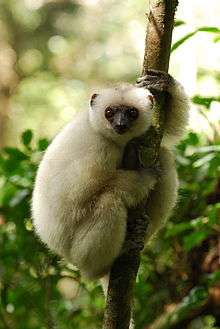
The World's 25 Most Endangered Primates is a list of highly endangered primate species selected and published by the International Union for Conservation of Nature Species Survival Commission Primate Specialist Group (IUCN/SSC PSG), the International Primatological Society (IPS), and Conservation International (CI).[1] The 2012–2014 list added the Bristol Conservation and Science Foundation (BCSF) to the list of publishers.[2] The IUCN/SSC PSG worked with CI to start the list in 2000, but in 2002, during the 19th Congress of the International Primatological Society, primatologists reviewed and debated the list, resulting in the 2002–2004 revision and the endorsement of the IPS. The publication has since been a joint project between the three conservation organizations and has been revised every two years following the biannual Congress of the IPS.[1] Starting with the 2004–2006 report, the title changed to "Primates in Peril: The World's 25 Most Endangered Primates".[3] That same year, the list began to provide information about each species, including their conservation status and the threats they face in the wild.[1] The species text is written in collaboration with experts from the field, with 60 people contributing to the 2006–2008 report[4] and 85 people contributing to the 2008–2010 report.[1] The 2004–2006 and 2006–2008 reports were published in the IUCN/SSC PSG journal Primate Conservation,[3][5] while the 2008–2010 and 2010-2012 report were published as independent publications by all three contributing organizations.[1][6]
The 25 species on the 2012–2014 list are distributed between 16 countries. The countries with the most species on the list are Madagascar (six species), Vietnam (five species), and Indonesia (three species). The list is broken into four distinct regions: the island of Madagascar, the continent of Africa, the continent of Asia including the islands of Indonesia, and the Neotropics (Central and South America). Five species have been on all seven published lists: the silky sifaka (Propithecus candidus), Delacour's langur (Trachypithecus delacouri), golden-headed langur (Trachypithecus poliocephalus poliocephalus), grey-shanked douc (Pygathrix cinerea), and the Tonkin snub-nosed monkey (Rhinopithecus avunculus).[2]
The purpose of the list, according to Russell Mittermeier, the president of CI, is "to highlight those [primate species] that are most at risk, to attract the attention of the public, to stimulate national governments to do more, and especially to find the resources to implement desperately needed conservation measures."[7] Species are selected for the list based on two primary reasons: extremely small population sizes and very rapid drops in numbers. These reasons are heavily influenced by habitat loss and hunting, the two greatest threats primates face. More specifically, threats listed in the report include deforestation due to slash-and-burn agriculture, clearing for pasture or farmland, charcoal production, firewood production, illegal logging, selective logging, mining, land development, and cash crop production; forest fragmentation; small population sizes; live capture for the exotic pet trade; and hunting for bushmeat and traditional medicine.[1]
Key
| Species | Common and scientific name of the species, including a picture if available |
|---|---|
| Years listed | Years the species has been included in the IUCN's list of the "Top 25 Most Endangered Primates" |
| Location(s) | Countries in which it is found |
| Estimated population | Latest population estimate from the IUCN |
| IUCN status | Conservation status of the species, per the IUCN as of the date of the latest list publication |
| Threats | A list of threats facing the species; used by the IUCN in assessing conservation status |
Current list
| Species | Years listed | Location(s) | Estimated population | IUCN status | Threats |
|---|---|---|---|---|---|
 Eulemur flavifrons |
2008 2010 2012 |
Madagascar | 450–2,300 | Critically endangered[8] |
|
| Northern sportive lemur Lepilemur septentrionalis |
2008 2010 2012 |
Madagascar | ~19 individuals in 2012 | Critically endangered[9] |
|
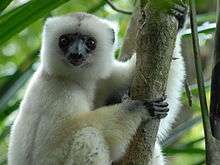 Propithecus candidus |
2000 2002 2004 2006 2008 2010 2012 |
Madagascar | <250 | Critically endangered[10] |
|
| Madame Berthe's mouse lemur Microcebus berthae |
2012 | Madagascar | <8,000 | Endangered[11] |
|
.jpg) Varecia rubra |
2012 | Madagascar | unknown | Endangered[12] |
|
 Indri indri |
2012 | Madagascar | unknown | Critically endangered[13] |
|
| Species | Years listed | Location(s) | Estimated population | IUCN status | Threats |
|---|---|---|---|---|---|
| Rondo dwarf galago Galagoides rondoensis |
2006 2008 2010 2012 |
Tanzania | unknown | Critically endangered[14] |
|
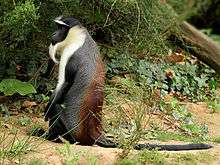 Cercopithecus roloway |
2002 2006 2008 2010 2012 |
Côte d'Ivoire Ghana |
unknown | Endangered[15] |
|
| Tana River red colobus Procolobus rufomitratus |
2002 2004 2006 2008 2012 |
Kenya | 1,100–1,300 | Endangered[16] |
|
| Bioko red colobus Piliocolobus pennantii pennantii |
2004 2006 2010 2012 |
Equatorial Guinea (Bioko Island) | <5,000 | Endangered[17] |
|
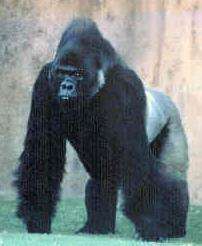 Gorilla beringei graueri |
2010 2012 |
Democratic Republic of the Congo | 2,000–10,000 | Endangered[18] |
|
| Species | Years listed | Location(s) | Estimated population | IUCN status | Threats |
|---|---|---|---|---|---|
 Nycticebus javanicus |
2008 2010 2012 |
Indonesia (Java) | unknown | Endangered[19] |
|
| Pig-tailed langur Simias concolor |
2002 2004 2006 2008 2010 2012 |
Indonesia (Mentawai Islands) | 700–3,347 | Critically endangered[20] |
|
| Delacour's langur Trachypithecus delacouri |
2000 2002 2004 2006 2008 2010 2012 |
Vietnam | <250 | Critically endangered[21] |
|
| Golden-headed langur Trachypithecus poliocephalus poliocephalus |
2000 2002 2004 2006 2008 2010 2012 |
Vietnam | 60–70 | Critically endangered[22] |
|
| Western purple-faced langur Trachypithecus vetulus nestor |
2004 2006 2008 2010 2012 |
Sri Lanka | unknown | Critically endangered[23] |
|
| Grey-shanked douc Pygathrix cinerea |
2000 2002 2004 2006 2008 2010 2012 |
Vietnam | 600–700 | Critically endangered[24] |
|
.jpg) Rhinopithecus avunculus |
2000 2002 2004 2006 2008 2010 2012 |
Vietnam | 200–250+ | Critically endangered[25] |
|
| Eastern black crested gibbon Nomascus nasutus |
2008 2010 2012 |
China Vietnam |
around 110 | Critically endangered[26] |
|
| Pygmy tarsier Tarsius pumilus |
2012 | Indonesia (Sulawesi) | unknown | Data deficient[27] |
|
| Species | Years listed | Location(s) | Estimated population | IUCN status | Threats |
|---|---|---|---|---|---|
.jpg) Ateles hybridus |
2004[N 1] 2006 2008 2010 2012 |
Colombia Venezuela |
unknown | Critically endangered[28] |
|
| Brown-headed spider monkey Ateles fusciceps fusciceps |
2006 2012 |
Ecuador | unknown | Critically endangered[29] |
|
| Kaapori capuchin Cebus kaapori |
2012 | Brazil | unknown | Critically endangered[30] |
|
| Rio Mayo titi Callicebus oenanthe |
2012 | Peru | unknown | Critically endangered[31] |
|
 Alouatta guariba guariba |
2012 | Brazil | <250 | Critically endangered[32] |
|
Former list members
With each new publication, species are both added and removed from the list. In some cases, removal from the list signifies improvement for the species. With the publication of the 2006–2008, four species were removed from the list because of increased conservation efforts: the black lion tamarin (Leontopithecus chrysopygus), golden lion tamarin (Leontopithecus rosalia), mountain gorilla (Gorilla beringei beringei), and Perrier's sifaka (Propithecus perrieri).[33] In 2008, the black lion tamarin went from critically endangered to endangered and the golden lion tamarin was similarly promoted in 2003 after three decades of collaborative conservation efforts by zoos and other institutions. Well-protected species such as these still have very small populations, and due to deforestation, new habitat is still needed for their long-term survival.[7] The Hainan black crested gibbon (Nomascus hainanus), which was removed from the 2008–2010 list, still has fewer than 20 individuals left, but significant efforts to protect it are now being made.[1] Mittermeier claimed in 2007 that all 25 species would be elevated off the list within five to ten years if conservation organizations had the necessary resources.[33]
Unlike the changes in the 2006–2008 report, not all species were removed from the 2008–2010 list due to improvement in their situation. Instead, new species were added to bring attention to other closely related species with very small populations that are also at risk of extinction. For example, the highly endangered eastern black crested gibbon (Nomascus nasutus) replaced the Hainan black crested gibbon. The Javan slow loris (Nycticebus javanicus) replaced the Horton Plains slender loris (Loris tardigradus nycticeboides) because the former has been hit the hardest of Asian lorises, all of which are declining rapidly due primarily to capture for the exotic pet trade, as well as use in traditional medicines and forest loss. In another case, the brown-headed spider monkey (Ateles fusciceps fusciceps) was omitted from the list since no spokesperson could be found for the species.[1] The same approach was taken with the 2012–2014 list.[2]
| Species | Years listed | Location(s) | Estimated population | IUCN status | Threats |
|---|---|---|---|---|---|
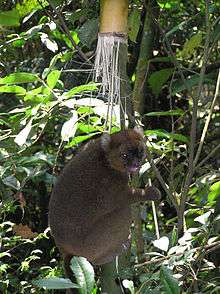 Prolemur simus |
2002 2004 2006 2008 2010 |
Madagascar | 100–160 or fewer | Critically endangered[34] |
|
 Varecia variegata |
2010 | Madagascar | unknown | Critically endangered[35] |
|
| Gray-headed lemur Eulemur cinereiceps |
2004 2006 2008 |
Madagascar | 7,265 ± 2,268 | Endangered[36] |
|
 Propithecus tattersalli |
2000 | Madagascar | 6,000–10,000[37] | Endangered[37] |
|
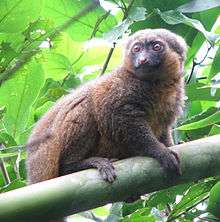 Hapalemur aureus |
2000 | Madagascar | fewer than 5,916[38] | Endangered[38] |
|
| Hapalemur alaotrensis |
2000 | Madagascar | around 2,500[39] | Critically endangered[39] |
|
 Lepilemur sahamalazensis |
2006 | Madagascar | unknown | Data deficient[40] |
|
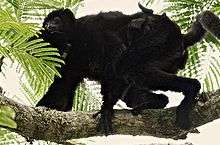 Propithecus perrieri |
2000 2002 2004 |
Madagascar | around 915[41] | Critically endangered[41] |
|
| Species | Years listed | Location(s) | Estimated population | IUCN status | Threats |
|---|---|---|---|---|---|
| Mt. Rungwe galago Galagoides sp. |
2004 | Tanzania | unknown | Not evaluated |
|
| Cercopithecus sclateri |
2000 | Nigeria | unknown | Vulnerable[42] |
|
 Mandrillus leucophaeus |
2000 | Cameroon Equatorial Guinea (Bioko) Nigeria |
unknown | Endangered[43] |
|
| Tana River mangabey Cercocebus galeritus galeritus |
2002 | Kenya | 1,000–1,200[44] | Endangered[44] |
|
 Cercocebus sanjei |
2000 2002 2004 |
Tanzania | fewer than 1,300[45] | Endangered[45] |
|
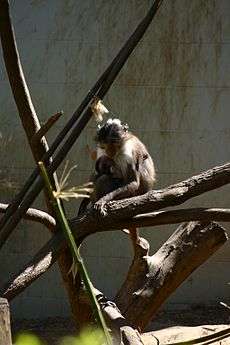 Cercocebus atys lunulatus |
2000 2002 2004 |
Côte d'Ivoire Ghana |
unknown | Endangered[46] |
|
| Miss Waldron's red colobus Piliocolobus badius waldronae |
2000 2002 2006 |
Côte d'Ivoire Ghana |
unknown | Critically endangered[47] |
|
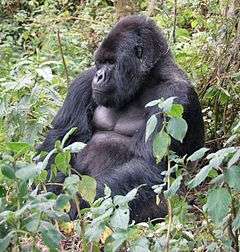 Gorilla beringei beringei |
2000 2002 2004 |
Rwanda Uganda |
around 600 | Critically endangered[48] |
|
| Niger Delta red colobus Procolobus epieni |
2008 2010 |
Nigeria | unknown | Critically endangered[49] |
|
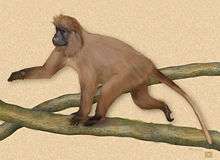 Rungwecebus kipunji |
2006 2008 |
Tanzania | around 1,117 | Critically endangered[50] |
|
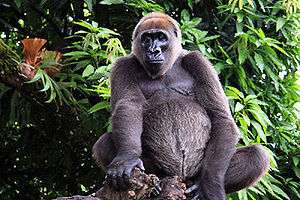 Gorilla gorilla diehli |
2000 2002 2004 2006 2008 |
Cameroon Nigeria |
200–300 | Critically endangered[51] |
|
| Species | Years listed | Location(s) | Estimated population | IUCN status | Threats |
|---|---|---|---|---|---|
| Horton Plains slender loris Loris tardigradus nycticeboides |
2004 2006 |
Sri Lanka | unknown | Endangered[52] |
|
| Natuna Island surili Presbytis natunae |
2002 | Indonesia | fewer than 10,000[53] | Vulnerable[53] |
|
| White-headed langur Trachypithecus poliocephalus leucocephalus |
2002 | China, Vietnam | fewer than 250 | Critically endangered[54] |
|
| Miller's grizzled langur Presbytis hosei canicrus |
2004 | Indonesia (Kalimantan) | unknown | Endangered[55] |
|
| Black snub-nosed monkey Rhinopithecus bieti |
2002 | China | fewer than 2,000[56] | Endangered[56] |
|
| Gray snub-nosed monkey Rhinopithecus brelichi |
2002 | China | around 750[57] | Endangered[57] |
|
 Hylobates moloch |
2000 | Indonesia (Java) | 4,000–4,500[58] | Endangered[58] |
|
 Nomascus hainanus |
2000 2004 2006 |
China (Hainan) | around 20[59] | Critically endangered[59] |
|
| Siau Island tarsier Tarsius tumpara |
2006 2008 2010 |
Indonesia (Siau Island) | Low thousands at best | Not evaluated |
|
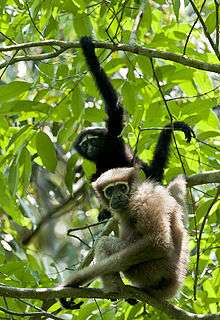 Hoolock hoolock |
2006 2008 |
Bangladesh India Myanmar |
fewer than 5,000 | Endangered[60] |
|
 Pongo abelii |
2000 2002 2004 2006 2008 |
Indonesia (Sumatra) | around 6,600 | Critically endangered[61] |
|
| Pongo pygmaeus pygmaeus |
2010 | Indonesia (West Kalimantan, Borneo) Malaysia (Sarawak) |
unknown | Endangered[62] |
|
 Macaca silenus |
2010 | India | <4,000 | Endangered[63] |
|
| Species | Years listed | Location(s) | Estimated population | IUCN status | Threats |
|---|---|---|---|---|---|
 Leontopithecus rosalia |
2000 | Brazil (Rio de Janeiro) | more than 1,000[64] | Endangered[64] |
|
 Leontopithecus chrysopygus |
2000 | Brazil (São Paulo) | around 1,000[65] | Endangered[65] |
|
 Leontopithecus caissara |
2000 2002 2004 |
Brazil (Paraná and São Paulo) | fewer than 400[66] | Critically endangered[66] |
|
 Cebus xanthosternos |
2000 2002 2004 |
Brazil (Bahia, Minas Gerais?) | unknown | Critically endangered[67] |
|
 Brachyteles hypoxanthus |
2000 2002 2004 |
Brazil (Bahia, Espírito Santo, Minas Gerais) | more than 855[68] | Critically endangered[68] |
|
 Oreonax flavicauda |
2000 2006 2008 2010 |
Peru | unknown | Critically endangered[69] |
|
 Saguinus oedipus |
2008 | Colombia | fewer than 6,000 | Critically endangered[70] |
|
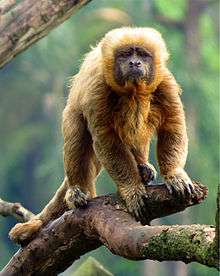 Cebus flavius |
2010 | Brazil | 180 | Critically endangered[71] |
|
List history
With the exception of the 2000–2002 publication, which was written collaboratively by the IUCN/SSC PSG and CI, the list has been revised every two years following the biannual Congress of the IPS. The 2002–2004 list resulted from the 19th Congress of the IPS in Beijing, China; the 2004–2006 list followed the 20th Congress of the IPS, held in Torino, Italy; the 2006–2008 list after the 21st Congress in Entebbe, Uganda; the 2008–2010 list followed the 22nd Congress held in Edinburgh, UK; the 2010-2012 list followed the 23rd Congress in Kyoto; and the 2012–2014 list after the 24th Congress in Cancún.[1]
The 2008 IUCN Red List of Threatened Species offered assessments of 634 primate taxa, of which 303 (47.8%) were listed as threatened (vulnerable, endangered, or critically endangered). A total of 206 primate species were ranked as either critically endangered or endangered, 54 (26%) of which have been included at least once in The World's 25 Most Endangered Primates since 2000.[1]
| Madagascar | Africa | Asia | Neotropics | |
|---|---|---|---|---|
| 2000–2002 |
| |||
| 2002–2004 |
|
|
| |
| 2004–2006 |
|
|
|
|
| 2006–2008 |
|
|
|
|
| 2008–2010 |
|
|
|
|
| 2010–2012 |
|
|
|
|
| 2012–2014 |
|
|
|
|
See also
Notes
- 1 2 3 4 5 The subspecies Ateles hybridus brunneus was listed in the 2004–2006 report, but the listing was expanded to cover both subspecies of Ateles hybridus starting with the 2006–2008 report.[1][3][5]
- ↑ In the 2000–2002 report, this lemur was listed as Propithecus diadema candidus, but it has since been reclassified as a separate species, Propithecus candidus.[1][72][73]
- ↑ In the 2000–2002 report, this lemur was listed as Propithecus diadema perrieri, but it has since been reclassified as a separate species, Propithecus perrieri.[1][72][73]
- ↑ In the 2000–2002 report, this lemur was listed as Hapalemur griseus alaotrensis, but it has since been reclassified as a separate species, Hapalemur alaotrensis.[1][72]
- 1 2 In the 2000–2002 and 2004–2006 reports, this gorilla was listed as Gorilla beringei, but other reports instead used Gorilla b. beringei.[1][3][72][73]
- ↑ In the 2000–2002 and 2002–2004 reports, the mangabey was listed as Cercocebus galeritus sanjei, but it has since been classified as a separate species, Cercocebus sanjei.[1]
- 1 2 3 In the 2000–2002, 2002–2004, and 2006–2008 reports, this colobus monkey was listed as Procolobus badius waldroni, but the spelling of the name has since been corrected to waldronae.[72][73][74]
- 1 2 In the 2000–2002 and 2002–2004 reports, this monkey was listed as Trachypithecus poliocephalus, but with other subspecies now recognized by the IUCN, it is now known as Trachypithecus p. poliocephalus.[1][3][72][73]
- 1 2 In the 2000–2002 and 2002–2004 reports, this douc was listed as Pygathrix nemaeus cinerea, but has since been recognized as a separate species, Pygathrix cinerea.[1][3]
- 1 2 In the 2000–2002 and 2004–2006 reports, this gibbon was listed as Hylobates concolor hainanus, but it has since been recognized as a separate species and placed in the genus Nomascus, so that it is known as Nomascus hainanus.[1][72]
- ↑ In the 2000–2002 report, this species was listed as Lagothrix flavicauda, but it has since been renamed to Oreonax flavicauda.[1]
- ↑ In the 2002–2004 report, this monkey was listed as Trachypithecus leucocephalus, but it is now considered only a subspecies, Trachypithecus poliocephalus leucocephalus.[1][73]
- 1 2 In the 2004–2006 and 2006–2008 reports, this species was listed as Eulemur albocollaris, but it has since been renamed to Eulemur cinereiceps.[1]
- ↑ In the 2006–2008 report, this tarsier was listed as "Tarsius sp.", but it has since been formally named as Tarsius tumpara.[1][5]
- ↑ The species Ateles fusciceps was listed in the 2006–2008 report, but the common name and description match the later identified subspecies, Ateles fusciceps fusciceps.[5]
References
- 1 2 3 4 5 6 7 8 9 10 11 12 13 14 15 16 17 18 19 20 21 22 23 24 25 26 27 28 Mittermeier, R.A.; Wallis, J.; Rylands, A.B.; Ganzhorn, J.U.; Oates, J.F.; Williamson, E.A.; Palacios, E.; Heymann, E.W.; Kierulff, M.C.M.; Long Yongcheng; Supriatna, J.; Roos, C.; Walker, S.; Cortés-Ortiz, L.; Schwitzer, C., eds. (2009). "Primates in Peril: The World's 25 Most Endangered Primates 2008–2010" (PDF). Illustrated by S.D. Nash. IUCN/SSC Primate Specialist Group (PSG), International Primatological Society (IPS), and Conservation International (CI): 1–92. doi:10.1896/052.024.0101. ISBN 978-1-934151-34-1.
- 1 2 3 4 5 6 7 8 9 Mittermeier, R.A.; Schwitzer, C.; Rylands, A.B.; Taylor, L.A.; Chiozza, F.; Williamson, E.A.; Wallis, J., eds. (2012). "Primates in Peril: The World's 25 Most Endangered Primates 2012–2014" (PDF). Illustrated by S.D. Nash. IUCN/SSC Primate Specialist Group (PSG), International Primatological Society (IPS), Conservation International (CI), and Bristol Conservation and Science Foundation (BCSF): 1–40.
- 1 2 3 4 5 6 7 Mittermeier, R.A.; Valladares-Pádua, C.; Rylands, A.B.; Eudey, A.A.; Butynski, T.M.; Ganzhorn, J.U.; Kormos, R.; Aguiar, J.M.; Walker, S., eds. (2006). Illustrated by S.D. Nash. "Primates in Peril: The World's 25 Most Endangered Primates 2004–2006" (PDF). Primate Conservation. IUCN/SSC Primate Specialist Group. 20: 1–28. doi:10.1896/0898-6207.20.1.1.
- ↑ L., Smith (26 October 2007). "Primates in peril: 25 species facing threat of extinction". The Times. Archived from the original on 5 August 2010. Retrieved 5 August 2010.
- 1 2 3 4 Mittermeier, R.A.; Ratsimbazafy, J.; Rylands, A.B.; Williamson, L.; Oates, J.F.; Mbora, D.; Ganzhorn, J.U.; Rodríguez-Luna, E.; Palacios, E.; Heymann, E.W.; Cecília, M.; Kierulff, M.; Yongcheng, L.; Supriatna, J.; Roos, C.; Walker, S.; Aguiar, J.M., eds. (2007). Illustrated by S.D. Nash. "Primates in Peril: The World's 25 Most Endangered Primates 2006–2008" (PDF). Primate Conservation. IUCN/SSC Primate Specialist Group. 22: 1–40. doi:10.1896/052.022.0101.
- ↑ Mittermeier, R.A.; Schwitzer, C.; Rylands, A.B.; Schwitzer, C.; Taylor, L.A.; Chiozza, F.; Williamson, E.A. (2012). "Primates in Peril: The World's 25 Most Endangered Primates 2010–2012" (PDF). IUCN/SSC Primate Specialist Group (PSG), International Primatological Society (IPS), Conservation International (CI), and Bristol Conservation and Science Foundation (BCSF): 1–40.
- 1 2 "World's most endangered primates revealed". IUCN News. 18 February 2010. Archived from the original on 5 August 2010. Retrieved 5 August 2010.
- ↑ Andriaholinirina, N.; Baden, A.; Blanco, M.; Chikhi, L.; Cooke, A.; Davies, N.; Dolch, R.; Donati, G.; Ganzhorn, J.; Golden, C.; et al. (2014). "Eulemur flavifrons". IUCN Red List of Threatened Species. Version 2008. International Union for Conservation of Nature. Retrieved 19 May 2015.
- ↑ Andrainarivo, C.; Andriaholinirina, V.N.; Feistner, A.; Felix, T.; Ganzhorn, J.; Garbutt, N.; Golden, C.; Konstant, B.; Louis Jr., E.; Meyers, D.; et al. (2008). "Lepilemur septentrionalis". IUCN Red List of Threatened Species. Version 2014.1. International Union for Conservation of Nature. Retrieved 1 January 2009.
- ↑ Andrainarivo, C.; Andriaholinirina, V.N.; Feistner, A.; Felix, T.; Ganzhorn, J.; Garbutt, N.; Golden, C.; Konstant, B.; Louis Jr., E.; Meyers, D.; et al. (2008). "Propithecus candidus". IUCN Red List of Threatened Species. Version 2008. International Union for Conservation of Nature. Retrieved 1 January 2009.
- ↑ Andrainarivo, C.; Andriaholinirina, V.N.; Feistner, A.; Felix, T.; Ganzhorn, J.; Garbutt, N.; Golden, C.; Konstant, B.; Louis Jr., E.; Meyers, D.; et al. (2008). "Microcebus berthae". IUCN Red List of Threatened Species. Version 2008. International Union for Conservation of Nature. Retrieved 21 March 2013.
- ↑ Andrainarivo, C.; Andriaholinirina, V.N.; Feistner, A.; Felix, T.; Ganzhorn, J.; Garbutt, N.; Golden, C.; Konstant, B.; Louis Jr., E.; Meyers, D.; et al. (2008). "Varecia rubra". IUCN Red List of Threatened Species. Version 2008. International Union for Conservation of Nature. Retrieved 21 March 2013.
- ↑ Andrainarivo, C.; Andriaholinirina, V.N.; Feistner, A.; Felix, T.; Ganzhorn, J.; Garbutt, N.; Golden, C.; Konstant, B.; Louis Jr., E.; Meyers, D.; et al. (2008). "Indri indri". IUCN Red List of Threatened Species. Version 2008. International Union for Conservation of Nature. Retrieved 21 March 2013.
- ↑ Perkin, A.; Bearder, S.; Honess, P. & Butynski, T.M. (2008). "Galagoides rondoensis". IUCN Red List of Threatened Species. Version 2008. International Union for Conservation of Nature. Retrieved 1 January 2009.
- ↑ Oates, J.F.; Gippoliti, S. & Groves, C.P. (2008). "Cercopithecus diana ssp. roloway". IUCN Red List of Threatened Species. Version 2008. International Union for Conservation of Nature. Retrieved 4 January 2009.
- ↑ Butynski, T.M.; Struhsaker, T. & De Jong, Y. (2008). "Procolobus rufomitratus ssp. rufomitratus". IUCN Red List of Threatened Species. Version 2008. International Union for Conservation of Nature. Retrieved 2008-11-27.
- ↑ Oates, J.F. & Struhsaker, T. (2008). "Procolobus pennantii ssp. pennantii". IUCN Red List of Threatened Species. Version 2008. International Union for Conservation of Nature. Retrieved 21 March 2013.
- ↑ Robbins, M.; Hart, J.; Maisels, F.; Mehlman, P.; Nixon, S. & Williamson, L. (2008). "Gorilla beringei ssp. graueri". IUCN Red List of Threatened Species. Version 2008. International Union for Conservation of Nature. Retrieved 21 March 2013.
- ↑ Nekaris, A. & Shekelle, M. (2008). "Nycticebus javanicus". IUCN Red List of Threatened Species. Version 2008. International Union for Conservation of Nature. Retrieved 10 August 2010.
- ↑ Whittaker, D. & Mittermeier, R.A. (2008). "Simias concolor". IUCN Red List of Threatened Species. Version 2008. International Union for Conservation of Nature. Retrieved 4 January 2009.
- ↑ Nadler, T.; Xuan Canh, L.; Ngoc Thanh, V. & Khac Quyet, L. (2008). "Trachypithecus delacouri". IUCN Red List of Threatened Species. Version 2008. International Union for Conservation of Nature. Retrieved 4 January 2009.
- ↑ Bleisch, B.; Xuan Canh, L.; Covert, B. & Yongcheng, L. (2008). "Trachypithecus poliocephalus ssp. poliocephalus". IUCN Red List of Threatened Species. Version 2008. International Union for Conservation of Nature. Retrieved 10 August 2010.
- ↑ Dittus, W.; Molur, S. & Nekaris, A. (2008). "Trachypithecus vetulus ssp. nestor". IUCN Red List of Threatened Species. Version 2008. International Union for Conservation of Nature. Retrieved 5 August 2010.
- ↑ Ngoc Thanh, V.; Lippold, L.; Nadler, T. & Timmons, R. J. (2008). "Pygathrix cinerea". IUCN Red List of Threatened Species. Version 2008. International Union for Conservation of Nature. Retrieved 4 January 2009.
- ↑ Xuan Canh, L.; Khac Quyet, L.; Thanh Hai, D. & Boonratana, R. (2008). "Rhinopithecus avunculus". IUCN Red List of Threatened Species. Version 2008. International Union for Conservation of Nature. Retrieved 5 November 2008.
- ↑ Bleisch, B. & Geissmann, T. (2008). "Nomascus nasutus". IUCN Red List of Threatened Species. Version 2008. International Union for Conservation of Nature. Retrieved 4 January 2009.
- ↑ Shekelle, M. & Salim, A. (2008). "Tarsius pumilus". IUCN Red List of Threatened Species. Version 2008. International Union for Conservation of Nature. Retrieved 21 March 2013.
- ↑ Urbani, B.; Morales, A.L.; Link, A. & Stevenson, P. (2008). "Ateles hybridus". IUCN Red List of Threatened Species. Version 2008. International Union for Conservation of Nature. Retrieved 3 January 2009.
- ↑ Cuarón, A.D.; Morales, A.; Shedden, A.; Rodríguez-Luna, E. & de Grammont, P.C. (2008). "Ateles fusciceps ssp. fusciceps". IUCN Red List of Threatened Species. Version 2008. International Union for Conservation of Nature. Retrieved 8 September 2010.
- ↑ Kierulff, M.C.M. & de Oliveira, M.M. (2008). "Cebus kaapori". IUCN Red List of Threatened Species. Version 2008. International Union for Conservation of Nature. Retrieved 21 March 2013.
- ↑ Veiga, L.; Bóveda-Penalba, A.; Vermeer, J.; Tello-Alvarado, J.C. & Cornejo, F. (2008). "Callicebus oenanthe". IUCN Red List of Threatened Species. Version 2008. International Union for Conservation of Nature. Retrieved 21 March 2013.
- ↑ Mendes, S.L.; Rylands. A.B.; Kierulff; M.C.M. & de Oliveira, M.M. (2008). "Alouatta guariba ssp. guariba". IUCN Red List of Threatened Species. Version 2008. International Union for Conservation of Nature. Retrieved 21 March 2013.
- 1 2 M., Casey (26 October 2007). "Primates in Trouble, Says Report on 25 Rarest". National Geographic News. Archived from the original on 5 August 2010. Retrieved 5 August 2010.
- ↑ Andrainarivo, C.; Andriaholinirina, V.N.; Feistner, A.; Felix, T.; Ganzhorn, J.; Garbutt, N.; Golden, C.; Konstant, B.; Louis Jr., E.; Meyers, D.; et al. (2008). "Prolemur simus". IUCN Red List of Threatened Species. Version 2008. International Union for Conservation of Nature. Retrieved 1 January 2009.
- ↑ Andrainarivo, C.; Andriaholinirina, V.N.; Feistner, A.; Felix, T.; Ganzhorn, J.; Garbutt, N.; Golden, C.; Konstant, B.; Louis Jr., E.; Meyers, D.; et al. (2008). "Varecia variegata". IUCN Red List of Threatened Species. Version 2008. International Union for Conservation of Nature. Retrieved 21 March 2013.
- ↑ Andrainarivo, C.; Andriaholinirina, V.N.; Feistner, A.; Felix, T.; Ganzhorn, J.; Garbutt, N.; Golden, C.; Konstant, B.; Louis Jr., E.; Meyers, D.; et al. (2008). "Eulemur cinereiceps". IUCN Red List of Threatened Species. Version 2008. International Union for Conservation of Nature. Retrieved 6 Oct 2008.
- 1 2 3 Andrainarivo, C.; Andriaholinirina, V.N.; Feistner, A.; Felix, T.; Ganzhorn, J.; Garbutt, N.; Golden, C.; Konstant, B.; Louis Jr., E.; Meyers, D.; et al. (2008). "Propithecus tattersalli". IUCN Red List of Threatened Species. Version 2008. International Union for Conservation of Nature. Retrieved 1 January 2009.
- 1 2 3 Andrainarivo, C.; Andriaholinirina, V.N.; Feistner, A.; Felix, T.; Ganzhorn, J.; Garbutt, N.; Golden, C.; Konstant, B.; Louis Jr., E.; Meyers, D.; et al. (2008). "Hapalemur aureus". IUCN Red List of Threatened Species. Version 2008. International Union for Conservation of Nature. Retrieved 1 January 2009.
- 1 2 3 Andrainarivo, C.; Andriaholinirina, V.N.; Feistner, A.; Felix, T.; Ganzhorn, J.; Garbutt, N.; Golden, C.; Konstant, B.; Louis Jr., E.; Meyers, D.; et al. (2008). "Hapalemur alaotrensis". IUCN Red List of Threatened Species. Version 2008. International Union for Conservation of Nature. Retrieved 1 January 2009.
- 1 2 Olivieri, G.; Schwitzer, C.; Schwitzer, N. & Craul, M. (2008). "Lepilemur sahamalazensis". IUCN Red List of Threatened Species. Version 2008. International Union for Conservation of Nature. Retrieved 1 January 2009.
- 1 2 3 Andrainarivo, C.; Andriaholinirina, V.N.; Feistner, A.; Felix, T.; Ganzhorn, J.; Garbutt, N.; Golden, C.; Konstant, B.; Louis Jr., E.; Meyers, D.; et al. (2008). "Propithecus perrieri". IUCN Red List of Threatened Species. Version 2008. International Union for Conservation of Nature. Retrieved 1 January 2009.
- 1 2 Oates, J.F.; Baker, L.R. & Tooze, Z.J. (2008). "Cercopithecus sclateri". IUCN Red List of Threatened Species. Version 2008. International Union for Conservation of Nature. Retrieved 5 November 2008.
- 1 2 Oates, J.F. & Butynski, T.M. (2008). "Mandrillus leucophaeus". IUCN Red List of Threatened Species. Version 2008. International Union for Conservation of Nature. Retrieved 4 January 2009.
- 1 2 3 Butynski, T.M.; Struhsaker, T.; Kingdon, J. & De Jong, Y. (2008). "Cercocebus galeritus". IUCN Red List of Threatened Species. Version 2008. International Union for Conservation of Nature. Retrieved 4 January 2009.
- 1 2 3 Ehardt, C.; Butynski, T.M. & Struhsaker, T. (2008). "Cercocebus sanjei". IUCN Red List of Threatened Species. Version 2008. International Union for Conservation of Nature. Retrieved 4 January 2009.
- 1 2 Oates, J.F.; Gippoliti, S. & Groves, C.P. (2008). "Cercocebus atys ssp. lunulatus". IUCN Red List of Threatened Species. Version 2008. International Union for Conservation of Nature. Retrieved 10 August 2010.
- 1 2 Oates, J.F.; Struhsaker, T. & McGraw, S. (2008). "Procolobus badius ssp. waldroni". IUCN Red List of Threatened Species. Version 2008. International Union for Conservation of Nature. Retrieved 4 January 2009.
- 1 2 Robbins, M.; Gray, M.; Kümpel, N.; Lanjouw, A.; Maisels, F.; Mugisha, A.; Spelman, L. & Williamson, L. (2008). "Gorilla beringei ssp. beringei". IUCN Red List of Threatened Species. Version 2008. International Union for Conservation of Nature. Retrieved 4 January 2009.
- ↑ Oates, J.F. & Struhsaker, T. (2008). "Procolobus pennantii ssp. epieni". IUCN Red List of Threatened Species. Version 2008. International Union for Conservation of Nature. Retrieved 6 August 2010.
- ↑ Davenport, T.R.B. & Jones, T. (2008). "Rungwecebus kipunji". IUCN Red List of Threatened Species. Version 2008. International Union for Conservation of Nature. Retrieved 17 November 2008.
- ↑ Oates, J.F.; Bergl, R.A.; Sunderland-Groves, J. & Dunn, A. (2008). "Gorilla gorilla ssp. diehli". IUCN Red List of Threatened Species. Version 2008. International Union for Conservation of Nature. Retrieved 4 January 2009.
- 1 2 Nekaris, A. (2008). "Loris tardigradus ssp. nycticeboides". IUCN Red List of Threatened Species. Version 2008. International Union for Conservation of Nature. Retrieved 10 August 2010.
- 1 2 3 Nijman, V. & Lammertink, M. (2008). "Presbytis natunae". IUCN Red List of Threatened Species. Version 2008. International Union for Conservation of Nature. Retrieved 2008-12-12.
- 1 2 Bleisch, B.; Xuan Canh, L.; Covert, B. & Yongcheng, L. (2008). "Trachypithecus poliocephalus ssp. leucocephalus". IUCN Red List of Threatened Species. Version 2008. International Union for Conservation of Nature. Retrieved 10 August 2010.
- 1 2 Nijman, V.; Meijaard, E. & Hon, J. (2008). "Presbytis hosei ssp. canicrus". IUCN Red List of Threatened Species. Version 2008. International Union for Conservation of Nature. Retrieved 10 August 2010.
- 1 2 3 Bleisch, W. & Richardson, M. (2008). "Rhinopithecus bieti". IUCN Red List of Threatened Species. Version 2008. International Union for Conservation of Nature. Retrieved 4 January 2009.
- 1 2 3 Bleisch, W.; Yongcheng, L. & Richardson, M. (2008). "Rhinopithecus brelichi". IUCN Red List of Threatened Species. Version 2008. International Union for Conservation of Nature. Retrieved 4 January 2009.
- 1 2 3 Andayani, N.; Brockelman, W.; Geissmann, T.; Nijman, V. & Supriatna, J. (2008). "Hylobates moloch". IUCN Red List of Threatened Species. Version 2008. International Union for Conservation of Nature. Retrieved 4 January 2009.
- 1 2 3 Geissmann, T. & Bleisch, W. (2008). "Nomascus hainanus". IUCN Red List of Threatened Species. Version 2008. International Union for Conservation of Nature. Retrieved 10 August 2010.
- ↑ Brockelman, W.; Molur, S. & Geissmann, T. (2008). "Hoolock hoolock". IUCN Red List of Threatened Species. Version 2008. International Union for Conservation of Nature. Retrieved 4 January 2009.
- ↑ Singleton, I.; Wich, S. A. & Griffiths, M. (2008). "Pongo abelii". IUCN Red List of Threatened Species. Version 2008. International Union for Conservation of Nature. Retrieved 4 January 2009.
- ↑ Ancrenaz, M.; Marshall, A.; Goossens, B.; van Schaik, C.; Sugardjito, J.; Gumal, M. & Wich, S. (2008). "Pongo pygmaeus ssp. pygmaeus". IUCN Red List of Threatened Species. Version 2008. International Union for Conservation of Nature. Retrieved 21 March 2013.
- ↑ Kumar, A.; Singh, M. & Molur, S. (2008). "Macaca silenus". IUCN Red List of Threatened Species. Version 2008. International Union for Conservation of Nature. Retrieved 21 March 2013.
- 1 2 3 Kierulff, M.C.M.; Rylands, A.B. & de Oliveira, M.M. (2008). "Leontopithecus rosalia". IUCN Red List of Threatened Species. Version 2008. International Union for Conservation of Nature. Retrieved 1 March 2009.
- 1 2 3 Kierulff, M.C.M.; Rylands, A.B.; Mendes, S.L. & de Oliveira, M.M. (2008). "Leontopithecus chrysopygus". IUCN Red List of Threatened Species. Version 2008. International Union for Conservation of Nature. Retrieved 2 January 2009.
- 1 2 3 Kierulff, M.C.M.; Rylands, A.B.; Mendes, S.L. & de Oliveira, M.M. (2008). "Leontopithecus caissara". IUCN Red List of Threatened Species. Version 2008. International Union for Conservation of Nature. Retrieved 2 January 2009.
- 1 2 Kierulff, M.C.M.; Mendes, S.L. & Rylands, A.B. (2008). "Cebus xanthosternos". IUCN Red List of Threatened Species. Version 2008. International Union for Conservation of Nature. Retrieved 2 January 2009.
- 1 2 3 Mendes, S.L.; de Oliveira, M.M.; Mittermeier, R.A. & Rylands, A.B. (2008). "Brachyteles hypoxanthus". IUCN Red List of Threatened Species. Version 2008. International Union for Conservation of Nature. Retrieved 8 November 2008.
- ↑ Cornejo, F.; Rylands, A.B.; Mittermeier, R.A. & Heymann, E. (2008). "Oreonax flavicauda". IUCN Red List of Threatened Species. Version 2008. International Union for Conservation of Nature. Retrieved 3 January 2009.
- ↑ Savage, A. & Causado, J. (2008). "Saguinus oedipus". IUCN Red List of Threatened Species. Version 2008. International Union for Conservation of Nature. Retrieved 2 January 2009.
- ↑ de Oliveira, M.M.; Boubli, J.-P. & Kierulff, M.C.M. (2008). "Cebus flavius". IUCN Red List of Threatened Species. Version 2008. International Union for Conservation of Nature. Retrieved 21 March 2013.
- 1 2 3 4 5 6 7 Mittermeier, R.A.; Konstant, W.R.; Rylands, A.B. (2000). "The World's Top 25 Most Endangered Primates" (PDF). Neotropical Primates. 8 (1): 49.
- 1 2 3 4 5 6 Konstant, W.R.; Mittermeier, R.A.; Rylands, A.B.; Butynski, T.M.; Eudey, A.A.; Ganzhorn, J.; Kormos, R. (2002). "The World's Top 25 Most Endangered Primates – 2002" (PDF). Neotropical Primates. 10 (3): 128–131.
- ↑ Groves, C.P. (2007). "The taxonomic diversity of the Colobinae of Africa". Journal of Anthropological Sciences. 85: 7–34.
External links
- The Top 25 Most Endangered Primates at the IUCN
